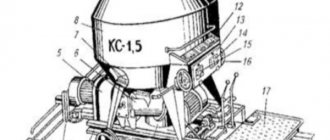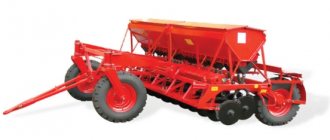Author: Oleg
01 November 2022 12:48
Tags: auto buses Nakhodka public transport oldtimer retro bus retro technology
24478
16
2
Last October, the collection of the St. Petersburg Museum of Buses, created under the wing of the St. Petersburg State Unitary Enterprise "Passenger Avtotrans", was replenished with a new exhibit - a ZIS-155 bus built in 1957. The find is unique in its own way: not only has such an ancient specimen survived to this day, but it has also arrived in a running and fairly complete condition!
0
Source:
See all photos in the gallery
In the distant fifties and sixties, it was the ZIS-155 that was the main bus in Soviet cities, which was a simplified version of the ZIS-154 bus, which was far ahead of its time. Instead of a diesel engine and an electric transmission (the forerunner of modern hybrids, by the way!) the ZIS-155 had a conventional gasoline engine and a manual transmission. Such machines served longer, and caused much fewer problems in operation.
Classic and contemporaries
0
Source:
The bus, which is only 60 years old, was miraculously preserved in the Stavropol region. The key to his longevity was his unusual profession: once upon a time he served as a sound reinforcement station ZS-1000. A sound reinforcement station is a bus covered with swear words that occasionally goes to May Day demonstrations and May 9 parades. Naturally, such cars do not carry passengers, and most of their lives are simply parked in garages. In the eighties, the sound amplification PAZ-672 arrived in Stavropol to replace the ZIS: more modern, powerful and compact. The ZIS was handed over to a communications center in the city of Svetlograd, which is a hundred kilometers from Stavropol to the north. In Svetlograd, the regional center of the Petrovsky district, it continued to work as a sound reinforcement bus at city events, and after a replacement arrived at the local communication center, it was converted “as is” into a passenger one, and became the official delivery service of the Svetlograd ETUS.
Variable conversion
Initially, two options for road trains were considered.
1. A tractor from a ZIS-155 bus, a trailer from a ZIS-155 bus with exhausted engine life.
2. A tractor from a ZIL-158 bus, a trailer from a ZIS-155 bus with exhausted engine life.
Buses used as tractors were subject to the following design changes.
1. On the ZIS-155 bus instead of the “native” engine with a power of 95 hp. an engine from a ZIL-158 bus with a power of 109 hp was installed.
2. In the gearbox, the gear ratios of the fifth gear were changed (from an overdrive to a lower gear - the gear ratio changed from 0.81 to 2.77).
3. The brake system was modernized by adding a third receiver with a capacity of 20 liters with output to the trailer. The manufacturer's brake valve was replaced with a MAZ-200 combined brake valve. The drive gear ratio from the engine to the compressor changed (from 1.24 to 0.85). The diameters of the compressor and fan pulleys changed accordingly.
The production of passenger trailers from decommissioned buses made it possible to reduce the costs of conversion and operation in bus depots. The steering, levers, pedals, engine with gearbox and transmission, driver's seat, mirrors, instruments, windshield wipers, cabin partition, driver's and engine compartment doors ("gate") with a lock, factory emblem, front bumper, headlights, headlights were removed from the buses. direction indicators and route indicators. Instead of the driver's doors, engine compartment and route light, cladding was installed. In the middle of the front end there were two small niches for connection and power supply to the electrical network and pneumatic system of the tractor. A slot was made in the lower part of the front end, allowing the coupling drawbar to move in one direction or another. By eliminating the driver's cabin, additional seats for four passengers were installed in the free space.
To couple the tractor with the trailer, a backlash-free coupling was used, for fastening it on buses a coupling hook was installed. The trailers were designed to work with a conductor, whose duties included opening and closing the trailer doors, so the door control valve was located at the conductor's place on the rear platform.
Stavropol, at the SPATP-1 checkpoint, 1997
0
Source:
In 1990, the former radio bus turned 33 years old: a respectable age that few people can achieve. Even then, the buses of the fifties became fossilized rarities - with a service life of 10-15 years, a rare bird lived twice as long; Moreover, enterprises steadily received new equipment, and the old one rarely remained in use. Thus, in Svetlograd they decided to put the ZIS out of service completely, but a miracle happened: the ZIS-155, which was going under the knife, was bought by the driver who worked on it, Yuri Maltsev from Stavropol.
Test results
In February - May 1960, experimental road trains underwent comprehensive tests, which showed the possibility of their operation during peak hours on the busiest routes, on the routes of which there are climbs of up to 8%. At the same time, no engine overheating was observed. The speed of the road train was 85% of the speed of a single bus. However, tests of the braking system on an ice-covered site near VDNKh demonstrated that emergency braking of the road train, especially on a slippery roadway, made its operation dangerous. The reasons for this were both the insufficient effectiveness of the brakes and the large mass of the trailer, especially when completely filled with passengers. In addition, the insufficient engine power of existing buses and trolleybuses, which were not designed to tow trailers, led to their overheating. While the MTB-82D trolleybus with a passenger trailer was moving along Nogin Square past the building of the CPSU Central Committee, which now houses the Administration of the President of Russia, the tractor caught fire. And although the fire was quickly extinguished, and no passengers were injured, the trolleybuses with trailers had to be abandoned.
ZIS-155 on a garden plot within Stavropol
0
Source:
Years passed. One in the field is not a warrior - and keeping the car running was the only thing that could be given to her alone, having only a garden plot. By chance, information about the surviving ZIS was received by the leader of the St. Petersburg bus museum RetroBus. The mission to find and get it was taken on by the most decent person Pavel Shilo: he managed to get the owner’s contacts and enter into successfully completed negotiations - for which both mentioned comrades hurray!, hurray!, hurray! Before the evacuation operation, the ZIS even got out of the cramped streets of gardening under its own power, and set off on a tow truck to a new life - to St. Petersburg
Trailer for a while
Experts have noted that on most routes the amount of passenger traffic depends on the time of day and days of the week. In particular, on lines connecting residential areas with the nearest metro stations, the highest passenger flow was observed at the beginning and end of the working day, when most Muscovites went to work or returned home. This prompted the idea of creating not a new high-capacity bus, but a passenger road train: a trailer adapted for transporting passengers was added to a regular city bus. This idea was not new: back in the 1930s, tests of ZIS-8 buses with “trailer saloons” - two-axle passenger trailers - were carried out in Moscow, and in the late 1950s - early 1960s. bus trains became widespread in Italy, Switzerland, Germany, East Germany, Hungary and Czechoslovakia, where they accounted for 18% of the total number of city buses.
Focusing on the European experience in operating bus trains, the Executive Committee of the Moscow City Council issued Order No. 4161 of November 5, 1959 for the Passenger Transport Administration of the Moscow City Executive Committee (UPTM). In pursuance of this order, UPTM issued order No. 284 of November 14, 1959, according to which the SVARZ plant was to develop documentation and manufacture five trailers for buses and trolleybuses by the end of 1960, using the bodies of decommissioned ZIS-155 buses, bus fleet No. 4 transferred to SVARZ one bus, park number 43-27, and bus depot No. 1 - four buses, park numbers MYA 13-79, 14-67, 14-75 and 14-78. By order of UPTM No. 307 of December 21, 1959, Bus Fleet No. 7 was ordered to transfer three decommissioned ZIS-155 buses, fleet numbers MYA 70-14, 70-50 and 70-07 without engine, transmission, gearboxes, axle axles for conversion into passenger trailers.
Technology implementation
A two-axle cargo trailer 2PN-4 from the Serdobsky Machine-Building Plant was chosen as the base chassis, on which, instead of an on-board platform, an all-metal passenger body was installed, which was maximally unified with the body of the ZIL-158 bus. The manufacture of the body and its installation on the trailer chassis was carried out by Moscow, which required its employees to have a higher production culture and master new technologies - until the early 1960s, the plant specialized in bodies with a wooden frame, and its technical equipment, according to L.I. Breiterman, left much to be desired: “When I got a job at AREMKUZ in 1954, having previously worked at MZMA, I had the impression that I was in some kind of workshop, and not in a large auto repair shop; at that time they didn’t know what the permit system was and landings, and the painting of the bodies was done with an ordinary brush, although of very high quality. Only in the mid-1950s did pneumatic drills and pneumatic hammers appear at the plant, and the introduction of spray guns, accompanied by an increase in the salaries of paint shop workers, oddly enough, led to their protest. People agreed to the same salary, just not to introduce complex mechanisms,” he recalls.
The trial operation of a road train consisting of a ZIL-158 bus and a passenger trailer on a 2PN-4 chassis, nicknamed “nephew,” was considered successful. And in 1960–1961. manufactured 50 bus trains. These road trains entered bus depot No. 2, where they were operated on the busiest routes until 1964. The first such train was the MMA 26-24 bus with the MO 09-19 trailer, which operated first on route 41 and then route 17. The first samples were equipped with a safety grill between the tractor and the trailer on the right side, which prevented pedestrians from falling under the trailer. The design of the road train provided for radio communication between the driver and the trailer conductor, which was almost never used in practice.
According to the recollections of veterans of the capital's bus transport, the introduction of these trains into operation was carried out with great difficulty. The park management treated them with suspicion, and the drivers were also not eager to master the new technology. Everyone saw the buses with “nephews” as unreliable equipment, which was a source of increased danger. The maximum speed of the road train was forcibly limited to 50 km/h. According to L.I. Breiterman, the braking system of the ZIL-158 was not effective enough: according to test results, the stopping distance of the bus was 12 meters, which is one meter more than international standards, and in actual operation it was even longer. “The flow area of the bus brake valve is 4 mm instead of 8 mm. When I turned to ZIL with my calculations, they answered me: “According to our methodology, everything is correct! Write in your diploma that bench tests have shown that changing the cross-section of the brake system does not qualitatively affect the braking efficiency. I didn’t think that a reputable plant would do this,” he recalls. At the same time, the interlocutor emphasized that during the entire period of operation of buses with trailers in Moscow, there was not a single accident involving them.
According to the engineer, during the preparation of his thesis, he had the opportunity to visit many metropolitan vehicle fleets operating freight road trains, while the release of a road train with a faulty air distributor, providing an emergency stop of the trailer in the event of a rupture of the coupling device, was the norm. This was due to the low reliability and imperfect design of the brakes. The problem was solved after NAMI specialists developed a new air distributor design, where the cuffs were replaced by round seals.
Side branch of evolution
A story about bus trains would be incomplete without mentioning the experimental cargo trailer, also designed and built at. The operation of ZIL-158 buses on lines connecting Moscow with airports turned out to be extremely difficult due to the fact that passengers on these lines had voluminous luggage with them, and the design of the bus did not provide luggage racks and storage areas on which this luggage could be placed . To solve this problem, AREMKUZ manufactured a single-axle cargo trailer for the ZIL-158 in 1959. By Order No. 131 of November 2, 1959, Bus Fleet No. 3, in which new and experimental equipment was undergoing trial operation in those years, was ordered to organize the operation of a bus with a cargo trailer on route No. 11, for which purpose it could be taken for temporary use from AREMKUZ. single-axle trailer and first make experimental trips without passengers in the presence of a commission on Moscow streets with little traffic. Unfortunately, this is all the information known to the author about this trailer.
To summarize, it can be argued that in the history of the Moscow bus, passenger trailers were a “side branch of evolution.” Despite their undeniable advantages, bus trains had a number of significant disadvantages, which turned out to be critical in the capital's operating conditions. Failures with their operation prompted designers to look for other ways to increase passenger capacity, the most effective of which was the operation of articulated buses.
But the history of passenger road trains in the USSR did not end there...
Technical characteristics of bus trains of three models
| Options | Tractor ZIS-155 trailer ZIS-155 | Tractor ZIL-158 trailer ZIS-155 | Tractor ZIL-158 trailer 2PN-4 | |||
| Length, mm | 17 785 | (8620 + 9525) | 18 555 | (9030 + 9525) | 15 900 | (9030 + 6870) |
| Capacity, persons | 113 | (52 + 61) | 123 | (62 + 61) | 102 | (62 + 40) |
| For seating, places | 58 | (28 + 30) | 62 | (32 + 30) | 51 | (32 + 19) |
| Total weight without load, kg | 11 170 | (6290 + 4880) | 11 380 | (6500 + 4880) | 9 950 | (6500 + 3450) |
| With full load, kg | 19 385 | (9930 + 9455) | 20 295 | (10840 + 9455) | 17 290 | (10840 + 6450) |
| Maximum speed without load, km/h | 40 | 40 | 40 | |||
| Maximum speed with full load, km/h | 30 | 30 | 40 | |||
The author expresses gratitude to Mikhail Vladimirovich Egorov and Lev Ilyich Breiterman for the materials provided and assistance in preparing the article.
Finding an alternative
Based on the test results, the designers had to abandon the conversion of decommissioned buses into trailers and develop an original passenger trailer with a lighter weight. This task was destined to be completed by Lev Ilyich Breiterman, an employee of the design department, who chose the creation of a bus train as the topic of his thesis.
“By the time I started working on the passenger trailer, I had already studied at the Correspondence Institute of Mechanical Engineering for several years,” recalls Lev Ilyich. – Work on the thesis project took more than two years instead of six months: I got so deep into this topic that I could no longer quit. A significant advantage of passenger road trains in those years was their greater adaptability to work in conditions of changing passenger traffic. During off-peak times, trailers can be uncoupled from buses, which allows saving on the number of rolling stock and providing transportation during peak hours. Thus, passenger trailers allow solving route maintenance issues with the greatest productivity and efficiency.”










